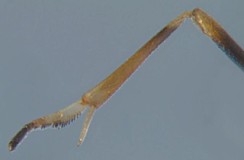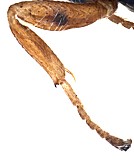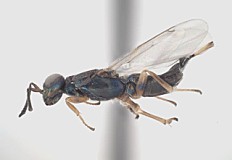Female Eupelmidae are readily recognized by the enlarged tibial spur and adjacent basitarsus on the mid leg (Fig. 2) as well as the rounded mesopleuron (Figs. 1, 4). Unlike members of the family Encyrtidae, which also have a rounded mesopleuron, the species of Eupelmus have distinct (usually broad and shallow) notauli. There are always 5 tarsomeres (Fig. 3). Male Eupelmus are difficult to identify, even to family.
Eupelmidae
Remarks
Several species of Eupelmus have been reared from fruit-infesting Tephritidae, most notably in Europe and Africa. At least two species have been reared from olive fly, Bactrocera oleae (Rossi), and one of these, Eupelmus urozonus Dalman is thought to be exceptionally polyphagous. The biology of E. urozonus is well known. This species has received considerable attention in the olive-growing regions of southern Europe because it is sometimes the most frequently encountered parasitoid of olive fly. Eupelmus urozonus is an ectoparasite, often of late instar larvae and sometimes of pupae. It can also develop as a hyperparasitoid of other olive fly parasitoids.
Distribution
No referenced distribution records have been added to the database for this OTU.
Map
There are no specimens currently determined for this OTU, or those specimens determined for this OTU are not yet mappable.




